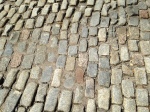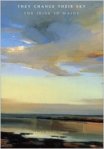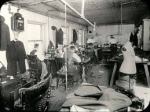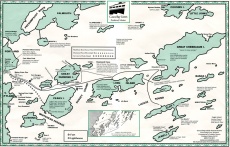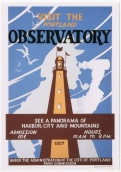When you ride the Peaks Island ferry at night, the ocean sparkles with the reflection of the lights from Portland. The city skyline is vastly different from the one my Dad sketched in 1985 – when the highest points were the spire of the Cathedral and the dome of the Observatory.
Today, instead of decrepit wharves and fish processing plants sprawled along the waterfront, there are gourmet food trucks, cruise ships, oyster bars, and boutiques. Newly built hotels are located across the street from historic brick buildings constructed after the Great Fire of Portland, July 4, 1866.
There is always nostalgia with regard to the past…for the history as well as the architecture. There are still cobblestone streets in Portland made from the ballast of ships that entered the harbor and stone fountains for horses that no longer walk the streets.
Following the demolition of Union Station to make way for a strip mall, preservationists within the community joined together to form the Greater Portland Landmarks.
http://www.pressherald.com/2011/08/31/the-ugly-birth-of-preservation_2011-08-31/
Never doubt that a small group of thoughtful, committed, citizens can change the world. Indeed, it is the only thing that ever has.”
I was raised to believe it is possible to affect change. When the Munjoy Hill East End Beach was closed due to pollution (before the construction of the sewage treatment plant), mothers (including mine) marched to City Hall to demand a pool be built so that kids would have a place to swim that summer.
Recently, a referendum was put to a vote by citizens of Portland to halt the sale of the Congress Street Park to a developer. As a result, the city is now creating a city-wide plan for open space.
Prologue
It was July 4th weekend when I finally arrived in Maine. Peaks Island traditions include a participatory parade, family picnics and cookouts on Back Shore, culminating in a fireworks display over Casco Bay.
When I was in 6th grade we had to memorize the preamble to the Constitution and the Declaration of Independence. At that time is was a memorization exercise; now it is the blueprint for nations around the globe who are pursuing democracy.
When in the Course of Human…
When in the course of human events, it becomes necessary for one people to dissolve the political bands which have connected them with another, and to assume among the powers of the earth, the separate and equal station to which the Laws of Nature and of Nature’s God entitle them, a decent respect to the opinions of mankind requires that they should declare the causes which impel them to the separation.
We hold these truths..….
We hold these truths to be self-evident, that all men are created equal, that they are endowed by their Creator with certain inalienable rights, that among these are life, liberty and the pursuit of happiness.
http://www.archives.gov/exhibits/charters/declaration_history.html
I am still conflicted about the concept behind the pursuit of happiness.
Is it happiness for an individual or for the greater good?
Do we pursue happiness for its own sake or to benefit others?.
Guide to Being an Aging Activist
On a holiday weekend, I paddle my kayak between 5:30 am and 9:30 am to avoid boat traffic. It is a quiet morning when I approach the osprey nests located in the bell buoys at either end of House Island.
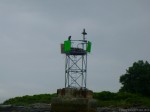 I have never been on the island as it has been privately held for many years. The owner purchased the island to preserve it and prevent development.
I have never been on the island as it has been privately held for many years. The owner purchased the island to preserve it and prevent development.
The doctor’s house, the old quarantine station and a smaller structure have always been visible. The 1904 immigration building had been demolished but the remaining foundation outlined the footprint of the structure.
Fort Scammel – built in built in 1808 of blocks of granite –anchors the opposite end of House.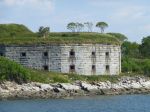
As I circumnavigated the island, the sounds of the osprey and her fledges were replaced with the sounds of machines. There was excavation equipment clearing the area near the former quarantine station.
 Something felt wrong. Yes, the island had been sold but no plans had been announced. Yes, the island did not have “official” historic designation, but Fort Scammel has long been a companion to Fort Gorges. I wondered if there were permits for what was taking place.
Something felt wrong. Yes, the island had been sold but no plans had been announced. Yes, the island did not have “official” historic designation, but Fort Scammel has long been a companion to Fort Gorges. I wondered if there were permits for what was taking place.
How to find a reporter on a holiday weekend
The Vinograds (David and Miranda) hail from England but have been long time summer people on Peaks. They have a penchant for old buildings – going so far as to dismantle one scheduled for demolition and then reconstructing it. (Their favorite bumper sticker: Gut Fish, Not Houses.)
When I shared with them the apparent demolition, they suggested I research recent articles about House Island and it’s sale. Sally Oldham (married to Ted the photographer of the 20,000 buildings in Portland….See most recent blog.) wrote an op ed piece in June, 2014 entitled: Properties in Peril. House Island was one of two properties featured.
She concluded:
…Physical preservation of the buildings and landscapes that embody these stories, such a rich part of Portland’s history, could make them the linchpins for successful developments.
We hope that there will be easy public access for Portlanders and tourists to the Portland Co. complex buildings and House Island’s Fort Scammel and at least exterior views of the immigration station buildings so important to this city’s past.
Over the coming months, Portlanders will want to carefully watch the developments proposed for each of these key complexes.
Tom Bell is a long time Press Herald writer and has covered development issues. I emailed him and he wrote back. I sent him photos of the apparent demolition work and all the documents and photographs I had collected. He called me for an interview.
How to contact city employees on a holiday weekend
Sending an email to the City of Portland permits, zoning, inspection, and historic preservation offices on July 4th felt like putting a note in a bottle, casting it into the sea and hoping it would be found quickly.
Meanwhile, the sounds of the machines continued.
I also contacted anyone who might have even a tangential interest in the island including the Audubon Society, Preservation Maine, and Greater Portland Landmarks.
I researched the Seashore Protection Act, Maine endangered species lists, and the decrease in monarch butterflies due to milkweed loss.
EVERYONE was on vacation.
I had no idea if other options were available to me to halt the work – at least temporarily. I needed a legal advisor.
And the machines continued.
How to find a lawyer (quickly) on a holiday weekend.
How would I find a lawyer on a holiday weekend and one that would be familiar with House Island?
Across from the Peaks Island library and adjoining Brad’s bikes is a window advertizing legal services and a number to call if you need a lawyer.
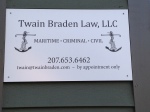 I called. He did not have the expertise I was seeking and referred me to Tom Federle. He provided his cell number. I called and left a somewhat cryptic message. I did not expect a response until the end of the long weekend.
I called. He did not have the expertise I was seeking and referred me to Tom Federle. He provided his cell number. I called and left a somewhat cryptic message. I did not expect a response until the end of the long weekend.
Within a few minutes, Tom returned my call. He was at his summer home on a nearby island.
His advice:
Let the City Offices have time to investigate the situation. Let them follow the established procedures. But, let’s create a Plan B.
But, the machines were still working.
How to gain the public’s attention on a holiday weekend
July 9, 2014 Portland Press Herald, front page headline:
Maine Island With Storied Past set for new chapter…
http://www.pressherald.com/2014/07/09/a-rewrite-for-island-near-portland-harbor-with-storied-past/
I decide to hide out in the Maine Historical Society (following my attorney’s advice) and conduct more research on the House Island quarantine station. A volunteer historian goes into the stacks and returns with a manila folder marked “ISLANDS.”
There were yellowed newspaper clippings, a few brochures, photographs of a variety of island and island events. Tucked within the mix was a small, 8-page booklet entitled:
Experiences of My Early Life on House Island on Casco Bay in Portland Harbor Portland Maine
by Roberta Randall Sheaff
Self-published in 1983, it is out of print.
It begins:
I was born on House Island, a quarantine station, in 1909 in one of three houses there.
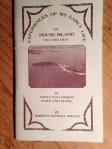 I looked up Roberta’s obituary. She died in Minnesota in 2004 at the age of 95. ‘She is survived by a daughter, son-in-law, grand children and many nieces and nephews.” I found her daughter’s address and telephone number in Duluth.
I looked up Roberta’s obituary. She died in Minnesota in 2004 at the age of 95. ‘She is survived by a daughter, son-in-law, grand children and many nieces and nephews.” I found her daughter’s address and telephone number in Duluth.
I called.
Benita Fuller-Fugelso talked freely about her mother and her mother’s love for House Island. Like most surviving children, Benita wished she had listened more carefully to the stories her grandparents and mother shared. She would now have a greater sense of the contribution her family made to the local history.
As we concluded our conversation she added:
“I have about 100 of my mother’s remaining books. I would be happy to give them to you to use in your efforts on my mother’s behalf to highlight the history of House. She would be thrilled to know her words will be shared with those who care about “her island.”…..
Generosity: kindness – willingness to give money, help or time freely.
How to Start a Controversy with Emails after a holiday weekend
Email #1: Zoning and Permits – Thank you for contacting us. I searched our records of the site and have not found any demo permits.
Email #2: Inspection Services – Inspections Staff will visit the island to ascertain the situation first hand.
Email #3: Greater Portland Landmarks – we request that a representative of the historic preservation office attend the inspection as well.
Email #4: Lawyer – I made the argument that he is re-engaging in demo work and that requires a demo permit. If he is removing foundations, I would argue it is demo, not clean up as he stated.
Email #5: Me – I request that House Island be considered a historic district.
Email #6: July 16th, the Historic Preservation Board meets to determine if they will move forward with the nomination of historic district. There is a multi phase process that culminates in 2 public meetings:
Preliminary workshop – August 6th to share report on history and significance of House Island.
Public Hearing – September 3rd
Email #7: Following the inspection, a stop work order was issued.
The machines stopped for 7 days.
Epilogue
I realize I cannot prevent the eventual development of House Island. I hope to encourage an examination and documentation of the buildings, the land, the fort, the untold history. I hope that its historical significance will be proven. Because –
When it’s gone, it’s gone.
I spent the morning, once again, kayaking across the channel from Peaks Island to House Island to observe the osprey. On this particular day, the fledglings were poking up from the nest. Mom and Dad were bringing them food and discouraging me from getting too close.
There is no reclamation of history when the physical evidence is removed.
When it’s gone; it’s gone forever.
Addendum
Please take the time to voice your opinion regarding the historic district designation of House Island, by contacting:
Deb Andrews, Historic Preservation, City of Portland
DGA@portlandmaine.gov
Or attend the public meetings.
I wish to thank the Joel and Linda Abromson Fund for their generous support of my research of the history of House Island and its relevance to the immigrant heritage of Portland.
